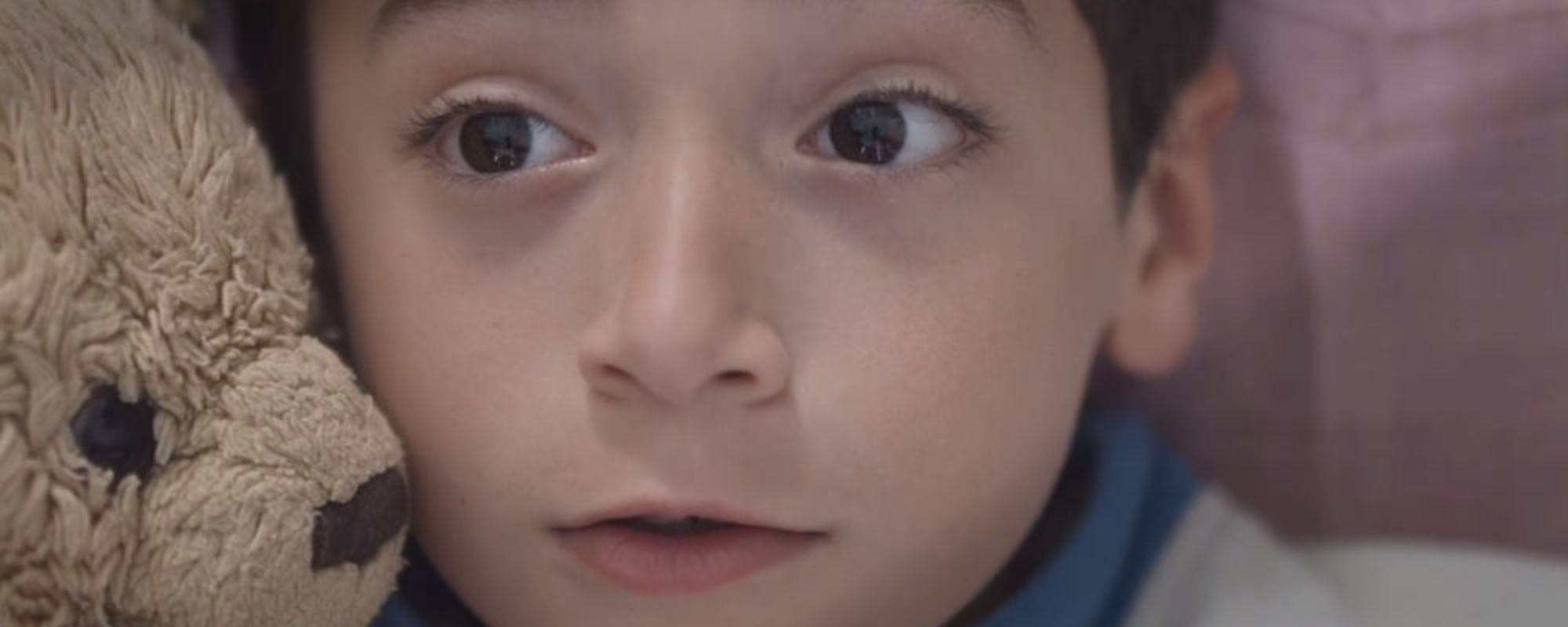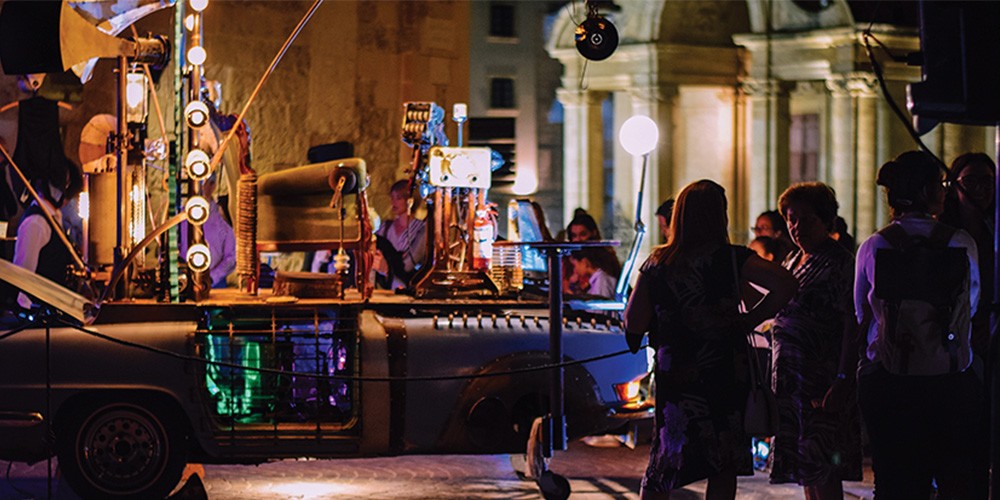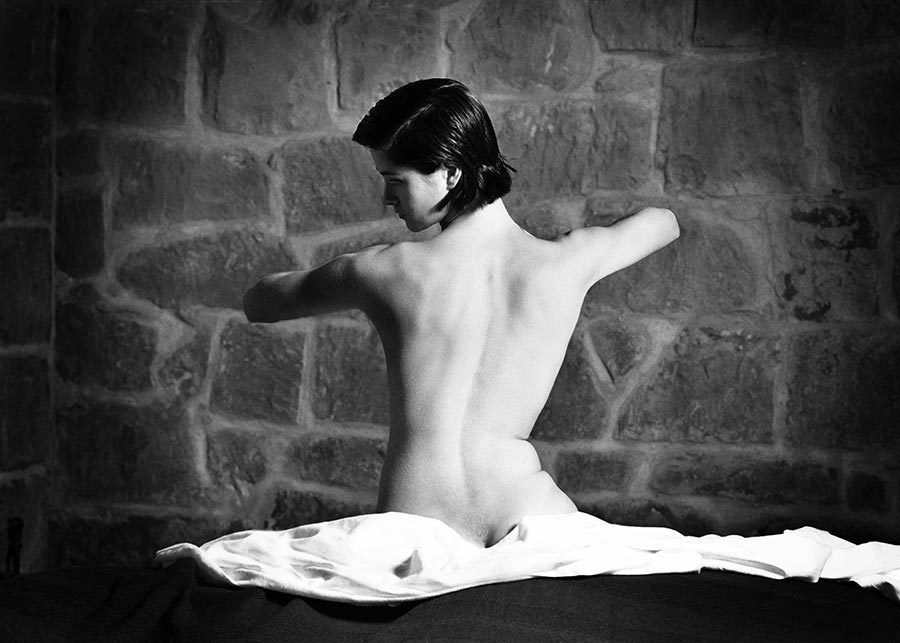As Malta celebrates its 20th anniversary within the EU, the 2024 EU National Institutes for Culture (EUNIC) Film Festival showcased the power of film to reflect Europe’s cultural mosaic. THINK explores what it means to be European.
Continue readingDark themes go places
Author: Kieran Teschner
Film is a medium that preserves life’s nuances for the future. It stimulates our senses in ways no other medium can, giving a unique, multilayered experience. Even a small-scale project can speak directly to people’s hearts when made with devotion to the filmmaking craft. The desire to capture a glimpse of the world through someone else’s eyes drove two groups of students to international recognition.
Continue readingPaintings in motion
Vince Briffa’s contribution to the Venice Biennale in 2019 is OUTLAND. An audio-visual piece inspired by The Odyssey, a story intimately linked to the Maltese islands’ own folklore, the work unfurls over many layers.
On one level, it explores the lure of safety and the numbness that can bring—exhibited through Ulysses’ portrayal, who is caught in a bubble of his own making. ‘The plastic room replaces the island from the story, presenting a different interpretation,’ explains Briffa. Here, it is Ulysses’ own mind and thoughts that keep him trapped.
The character of Calypso is also a reflection of the theme MALETH—port and safe haven. ‘She is both a lover and oppressor,’ Briffa says. ‘Calypso offers a haven for Ulysses during the seven years he spends harboured in her cave. But he is also her prisoner.’
Finally, there is fragmentation and distortion to create new from old. Penelope is Ulysses’ waiting wife, torn between longing for her husband’s safe return and an uncertainty she secretly harbours—is that even what she truly wants? Her presence in the work comes through the use of Emmanuel Mifsud’s poem Penelopi Tistenna (‘Penelope waits’). For Briffa, the Maltese language helps the story ‘take on a different life.’

The work’s duality is apparent. Images are juxtaposed against one another. One can observe two characters simultaneously, living their own truths and challenging each other. However, the conflict is not structured. ‘It’s a contemporary art piece, not film. There is no story. It’s more of a painting. I am, myself, a painter first,’ Briffa notes.
So for those who find a narrative in this piece, know that it is uniquely yours. The question now is: will you share it?
To watch and read more about OUTLAND visit www.vincebriffa.com
Kemmuna
Despite being one of Malta’s hottest attractions, a lot of what Comino has to offer is covered by the cool blue waters that fuel its popularity. Prof. Alan Deidun and his team have embarked on a journey to bring what’s hidden beneath to the surface, tentacles and all.
Have you ever googled Comino? Approximately 10,900,000 results pop up, and the vast majority of them relate to holidaymaking tips and weather information, with a sprinkling of research projects. Once the hideout of pirates and smugglers, the little island’s crystal-clear waters have now made it a paradise for travellers. But despite the suffocating love and attention Comino gets during the summer months, many of its wonders remain hidden underwater, unattainable to most.
This was the motivation behind Prof Alan Deidun’s most recent documentary, Comino: A Secret Paradise. An academic at the Department of Geosciences (University of Malta), Deidun is an avid diver, environmentalist, and advocate who wants ‘to bring the underwater world to people who don’t normally venture beyond the swimmer’s zone.’
Deidun’s first foray into documentary filmmaking came with Dwejra (2012), a film that featured the long-lost Azure window. Soon after were Rdum Majjiesa (2012) and Mġarr ix-Xini (2013). His big break came with Filfla (2015) which went viral and continues to do rounds on social media today. Even in 2012, the aim was always to highlight the beauty and importance of local Marine Protected Areas. In 2019, this has not changed.
Behind the scenes
The team met to film the first documentary in the series back in 2012 with Monolith Limited. The experience was so positive and fruitful that the team has remained practically unchanged since. Film after film, they all keep coming back to work together. Directed by Pedja Miletic and funded by the Malta International Airport Foundation, Comino is the fifth film in the series.
Filming took place throughout 2018, focusing on everything: marine to terrestrial, shallow to deep, diurnal to nocturnal. Deidun admitted that the team struggled with finding and filming enough organisms. ‘It took around 50 trips to Comino and back to get the footage we needed,’ he says. But the result speaks for itself.
Helping them achieve the sheen they needed for the final work, Deidun and his colleagues used a state-of-the-art 8K underwater camera. Hardware of this calibre is the sort you find on big budget productions like the BBC’s beloved Blue Planet. The camera enabled the divers to film animals from a different perspective, providing audiences with a new experience. Take, for example, the Common Octopus, Octopus vulgaris, a documentary staple whose camouflaging skills got some well-deserved attention in Comino. The camera also came in handy with more delicate, elusive creatures. The weird and wonderful Berried Sea Anemone and the Flying Gurnard, species the team hadn’t been able to capture in previous work, could now be seen in all their complexity.
Science & art for the environment
The motivations behind this documentary are complex, but one big factor Deidun mentions is a lack of science communication—a global issue.
Deidun emphasised that academics need to share their findings. ‘You can’t just publish in a peer-reviewed journal and stop there,’ he says. ‘You need to engage, start a dialogue with society.’ Because despite all of us choosing different walks of life, we share one home, and scientific findings should influence how our environment is treated. To move from research to societal action, communication is key. Scientific findings on their own quickly become stagnant, but through discussion and dialogue, they can thrive in the different layers of our communities: from quick, friendly conversations to formal government conferences. A conscious understanding of our environment leads to its conscious use.
In this case, Comino can help engage people with marine diversity and show them this complex micro-realm that ‘is not just Blue Lagoon.’
Most people know about the Damselfish (Ċawla in Maltese) or the Mauve Stinger (BRAMA! in Maltese). This might make people think that Maltese waters are safe from overexploitation, but this is far from the truth.
The animals that are difficult to see are those that need the most attention. Fauna such as the endangered Rough Ray, the protected, crimson purple Echinaster sepositus starfish and the Striped Prawn all face man-made threats.
‘This has resulted in an alarmingly low fish biomass [amount of fish] for the Maltese waters,’ Deidun says. ‘But that’s not surprising. Maltese waters are constantly fished. Overfishing is a reality.’ Even Comino, a Marine Protected Area (MPA), is surrounded by nets and fishing lines. It seems that while most of us are proud of our crystal-clear waters, we are not paying attention to the problems ailing it. ‘This is what we hope to change,’ Deidun adds.’
Comino’s future; our future
Deidun has plenty of hope. He tells us that ‘our MPAs are paper tigers for now, but the Environmental Resource Authority (ERA) is working on having approved management plans’ which need to be ready and presented to the European Commission by the end of 2019—a step towards a healthier sea with a sustainable future.
As for the future of these documentaries, Deidun has big plans, and they involve Netflix. He also wishes to add the films to digital libraries of local schools. In time, this will all feed into his vision of establishing a local ocean literary centre, a space where people of all ages can learn about our sea through science, arts, and new technology.
The Maltese are an island people. The sea is part of our heritage, a part of our identity. And we must work harder to preserve it for future generations. It is through documentaries like this one that we can appreciate and protect our home. As biologist Jane Goodall once said, ‘Only if we understand, can we care. Only if we care, we will help. Only if we help, we shall be saved.’
The Maltese Time Machine: Magna Żmien
As I write this article, a box full of 8mm film has just been delivered to our studio. On these tapes is local home footage featuring carnival celebrations from the 1960s, a visit by the UK’s Queen Elizabeth II, and an assorted series of family events recorded around the Maltese Islands. These films are valuable historical records opening a window onto the unfiltered and uncensored perspective of Maltese citizens. Magna Żmien is a Valletta 2018 project coordinated by artistic director Andrew Alamango and a collective of like-minded individuals. The purpose of the project is to collect and preserve historic Maltese content recorded on home sound, image, and video equipment over the past century. Left neglected, these personal documents containing evidence of Malta’s changing landscapes—physical, social, and political—might have been lost and forgotten. Instead, the team is reusing them, reinterpreting them through art.
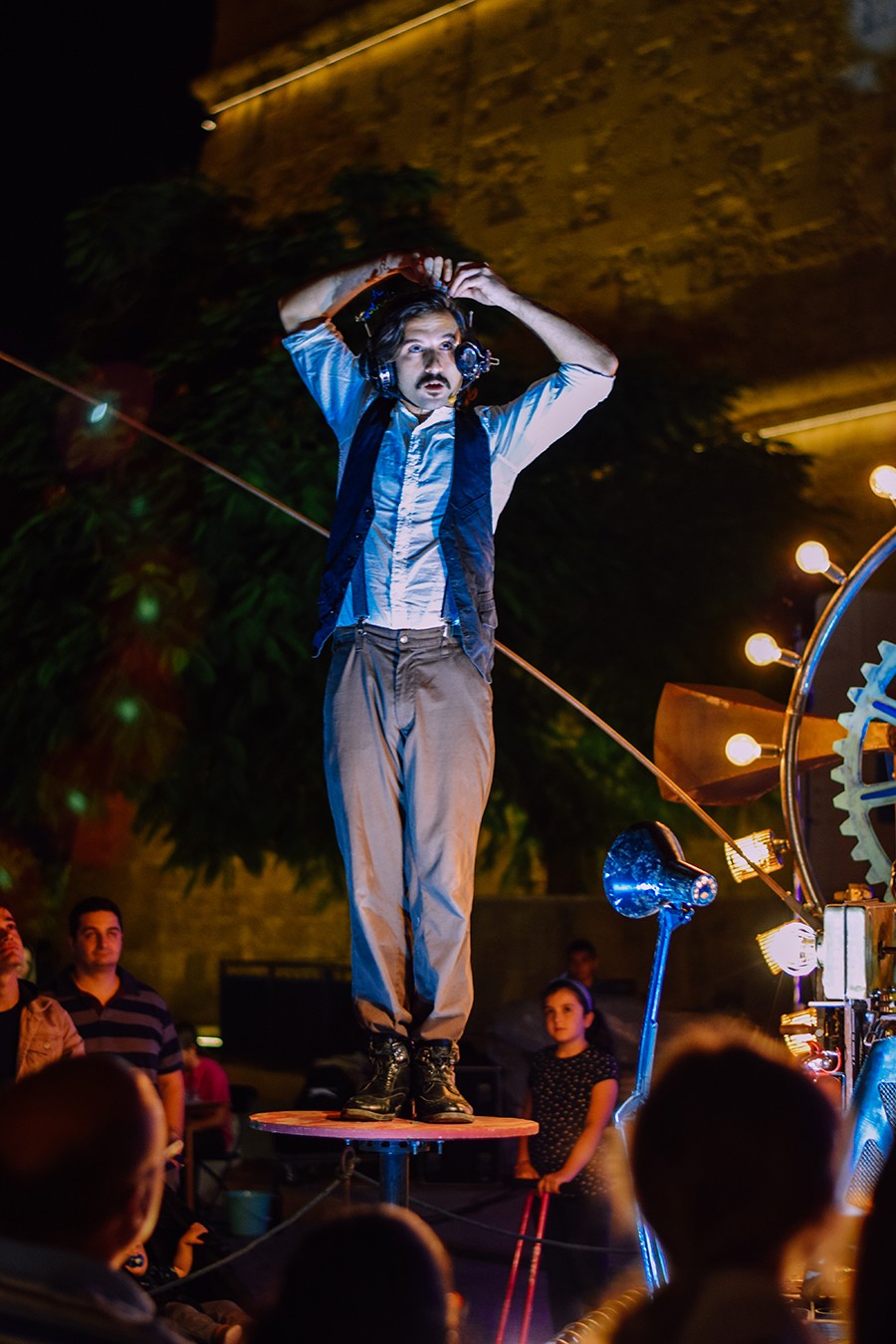
The move to digitise and make available fading analogue memories is physically manifested through ‘The Magnificent Memory Machine’—the Kapsula Merill, designed and built by Matthew Pandolfino, Andre Vujicic and Late Interactive. In the driver’s seat is Armchair Voyager Wistin (Jacob Piccinino). Behind the scenes is the professional studio that makes it all happen, digitising open reel tapes, audio cassettes, vinyl, Super 8 and 8mm film, photographs, negatives, and slides at high resolution. Since February 2018, we have digitised over 2,000 items from 51 different donors, in addition to receiving a further 600 digital files from private collections.
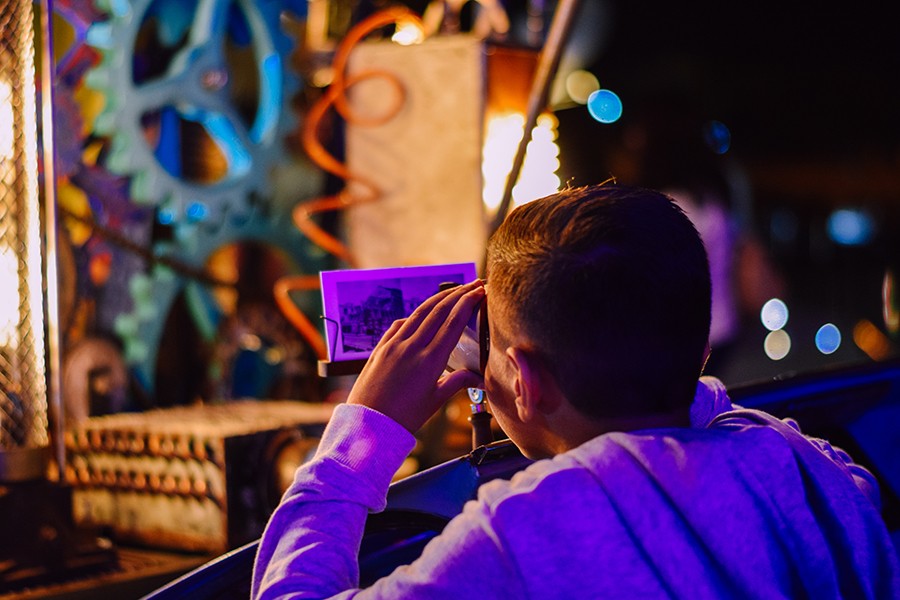
The collected material has many stories to tell. Our performance events throughout 2018, including at Science and the City and Malta Café Scientifique, only scratch the surface when it comes to the sheer volume of material we have been allowed to copy by donors.
One thing we often encounter is the personal voice message—greetings between diasporic Maltese. Dating back to the 1950s, these appear most frequently on open reel and audio cassette tape, but also on special vinyl discs. One particular recording is by a man named Charlie who recorded his message in a Calibre booth on a platform at London Waterloo station. In the message, Charlie sends wishes to his family and regales them with tales of all the football matches he is attending, one of which he is particularly excited about: England vs East Germany. Some minor detective work has revealed that this recording was made on 24 November 1970 when England beat East Germany three goals to one.
Messages such as these may seem inconsequential, but of all the voice recordings we have heard, they are perhaps among the most honest. Recorded in a busy, alien environment under strict time constraints, the speakers didn’t have the luxury of retakes before their voices were forever fixed on vinyl.
Magna Żmien will continue to collect sounds, images, and videos like these, and present its research in innovative contexts beyond 2018. We want to continue engaging citizens in the technical and cultural components at the heart of our project. Agreements are also underway to establish a formal association between Magna Żmien and the National Archives, ensuring the longevity of this material as public documents are accessible to all. What we collect, after all, belongs to the Maltese people at home and abroad. The recordings contain an essence of our national identity that cannot and should not be lost.
For more, visit: www.magnazmien.com
Author: Andrew Pace for the Valletta 2018 Foundation
Text feeds text, feeds art
Cassi Camilleri goes on a rollercoaster ride into the relationship between the Humanities and film with Prof. Gloria Lauri-Lucente and Dr Fabrizio Foni. Together, they unpack the debate on film adaptation and points of origin.
Lights, Camera and Ken
Filmmaker Kenneth Scicluna originally wanted to work in computer animation but finally found his calling in film. Veronica Stivala joins him on his journey so far, which despite being rather distressing at times, is also one that brings with it some rewards.
Literature will break your heart
Dr David Vella interviews Dr James Corby to find out how literature can help you face tragedy in your life. Illustrations by Sonya Hallett.
Continue readingRang-e Khoda (The Colour of Paradise)
Charlo Pisani reviews the Iranian film released in 1999.
Continue readingIt Follows — Film Review
Noel: Early in the film, Jay (Maika Monroe) asks Hugh/Jeff (Jake Weary) to pick a random stranger with whom he wouldn’t mind switching lives. Curiously enough he chooses a little boy because he envies his ‘total freedom’, going ‘to the bathroom any time [he wants]’ and ‘get[ting] away with that’.
It’s telling that, out of all possibilities, Hugh/Jeff goes for toilet duties. Apparently he yearns for a regressive state in which his ego is not yet fully formed, one in which he is fully dependent on an outside agency. It’s a strange thing coming from a young man on the cusp of adulthood. However this is a theme that runs through the entire film: a sort of coming of age tale in reverse.
The protagonists in It Follows seem to be battling against the relentless passage of time. They are doing things that grown-ups do, including sex; yet they still want to be like that little boy and shed responsibility. By doing so they subvert one of the main tropes of the slasher film, a sub genre which It Follows certainly endorses: sex as a rite of passage from childhood into adulthood.
Jay repeatedly uses the house pool. With our Freudian hats on, the pool becomes an obvious reference to her trying to reclaiming the security of her mother’s womb. It’s her comfort zone and she goes there to be on her own, to feel safe. We never see her share the pool with anyone else.
It is revealing though that when Jay (supposedly) has sex with three men in a boat, she goes back to the pool only to find it broken and empty of water. This suggests that her indiscriminate choice of sexual partners has robbed her of a substantial amount of that yearned for ‘childhood innocence’. She has crossed the point of no return, another manifestation of which is the murderous spectre that is ruthlessly following her.
“The nuclear family has jumped ship. There is nobody to whom the young generation can turn to for advice and they are left to cope on their own.”
The adult world is conspicuously absent. We rarely come across grown-ups and when we do they seem to inhabit a different world. Take when Jay enters the living room garbed in a towel, as her sister and her friends are watching tv. Their mother is at the back of the shot, totally immersed in her glass of wine and phone conversation, visually cut off by a wooden beam and separate lighting. It happens again when Jay is talking to a policeman. The camera is placed very low, giving us a child’s point of view, and the officer is nothing but a disembodied bit of trouser leg.
The nuclear family has jumped ship. There is nobody to whom the young generation can turn to for advice and they are left to cope on their own. It Follows is an anti-coming of age tale because there is no conflict between the young and the old, and without conflict there is no growth.
Krista: It Follows has received widespread recognition making ripples outside the niche/cult horror community. Film critic Mark Kermode commented on its ‘art-house’ distance from genre conventions. Horror films that challenge boundaries are hardly rare; however, few receive such wide recognition. The reasons are rooted in how certain film genres are viewed, which is problematic. This leads to the elevation of films that seemingly transcend genre.
It Follows has won recognition, while embracing its genre-allegiance.
Its quasi-climactic pool scene is reminiscent of the finale in Cronenberg’sShivers (1975). Both films feature a kind of infectious sexual awakening. However, where Shivers is celebratory, orgiastically joyful, the sex in It Follows feels oddly uneventful. Though the climax takes place in a communal pool, it follows the pattern established in the previous house pool scenes—Jay is isolated within the larger pool.
The film’s use of space reinforces this impression of isolation. Though in the vein of coming-of-age movies, the film foregrounds friendship, there is a sense of extended silence, isolation—a space of waiting, never fully breached. As the teacher reads TS Eliot’sThe Love Song of J. Alfred Prufrock, Jay sits at the far end of a long table on her own. This is reinforced in scenes showing expanses of sea and sand and grey, with a slow walking ‘it’ that follows Jay. The slowness of this sinister presence that permeates the film is reminiscent of Hancock’sLet’s Scare Jessica to Death (1971) and Blatty’sExorcist III: Legion (1990).
There is anticipation, but as Noel notes, there is no corresponding growth. The film lacks a climax – dread settles, quietly. On the way to the pool, Yara (Olivia Luccardi), one of Jay’s friends reminisces: ‘when I was a little girl, my parents wouldn’t allow me to go south of 8 Mile. And I didn’t even know what that meant, until I got a little older, and I started realising that that’s where the city started, and the suburbs ended.’ The film positions itself in a moment of suspension, never leaving the suburbs, calling: ‘there will be time, there will be time…’ But time for what?


